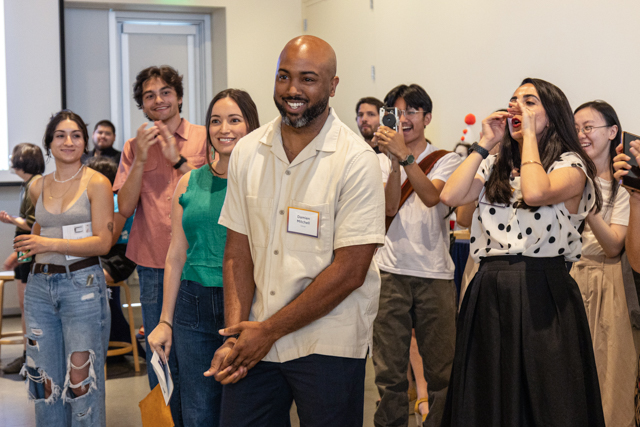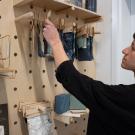
Lifelong ‘maker’ Damien Mitchell takes his UC Davis education back to Louisiana
Footwear is something Damien Mitchell has always been drawn to. The industrial designer and design M.F.A. alum enjoys designing them and sewing them. Scrolling through Mitchell’s Instagram, it’s clear to see he enjoys making shoes — eye-catching, make-you-look-twice kinds of shoes.

At the 2024 UC Davis Arts & Humanities Graduate Exhibition, Mitchell made a splash with his innovative, sustainable, thoughtful and stylish footwear designs in his display, “Re/Pair: A Fusion of Handcraft and Digital Fabrication in Shoemaking.” He was even awarded the Savageau Award for Design, which is named after Ann Savageau, a professor in the Department of Design from 2007 to 2014, and is awarded to one graduating student from the design M.F.A. program each year.
“I think, just culturally being a young Black kid, you always wanted to have the coolest sneakers. That was very much a part of the culture that I grew up in,” Mitchell said. “At a certain point, I thought it would be interesting for me to make those cool sneakers or try to, at least, and it just evolved from there.”
If a sneaker grows in the forest ...
Mitchell has been creating things for as long as he can remember. His mother is a seamstress, his stepfather is an all-around handyman, mechanic and carpenter, and his father is a chef.
“All of these people around me make things, so it just made sense for me to do the same,” Mitchell said.
Combining technologies like 3D-printing with traditional craftsmanship has been a theme in Mitchell’s own work. While earlier creations used mostly leather, Mitchell has experimented with all sorts of materials and techniques. One of the pair of shoes featured in his “Re/Pair” project was constructed using fish leather and biodegradable polymers.
“I knew I was going to be making shoes when I got here, but I didn’t know I was going to be making shoes made of methane-eating bacteria and fish skin,” Mitchell said after the exhibition.

Though that particular prototype wasn’t suitable for long-term use, the biodegradable polymers he used are getting better and will last longer in the future, Mitchell added. In general, he said, the shoe industry uses a lot of “toxic plastics and glues,” and those materials are difficult to get away from.
Though Mitchell’s work tended to be sustainable, as many handmade products are, he wasn’t focused on that aspect of design until studying at UC Davis with Beth Ferguson. Ferguson, an associate professor of design, is an ecological designer and the faculty lead advisor for the Eco Materials Library on campus.
“Being able to make things, in general, changes how I act as a consumer,” Mitchell said. “When I’m looking to buy something, the first question is: Can I make this? Then, it’s like, do you have time to make this? Is this something you want to spend your time doing?”
Now that he knows the impact of textile waste on the planet, Mitchell said it’s hard not to think about that even when buying something as basic as socks.
According to the latest data and estimates from the Environmental Protection Agency (EPA), U.S. generation of textiles in 2018, long before more fast-fashion brands took off on social media, was 17 million tons. The majority of that waste went to — and continues to go to — landfills.
Sustainable, community-driven design
Going forward, Mitchell is interested in designs that are not only sustainable but entirely local. That means they’re made from materials grown and produced in the same community the final product is created in, sold in, used in and repaired or recycled in.
Today, Mitchell is a faculty member at the University of Louisiana at Lafayette School, where he completed his undergraduate degree, helping his students reach their potential in design and beyond.
“I think helping people navigate their own creativity is always fun for me, to see that lightbulb go off is really energizing,” Mitchell said. “My students are exploring design through a combination of digital fabrication and traditional craft techniques.”
Since the M.F.A. program, Mitchell said he’s “a bit more critical not only in my thinking process or my design process but critical of the references that I use in my work.”
“I’m more thoughtful about the decisions I make through design,” he added. And in his teaching, Mitchell hopes to encourage up-and-coming designers to be thoughtful as well.
“We need to help build these thoughtful designers that will help make these positive changes in the world,” he said.
YOU MAY ALSO LIKE THESE STORIES

Slowing Down Fast Fashion: Alum Uses Mushrooms to Change Clothing Industry
Alejandra Ruiz, M.F.A. ’23, is using mushrooms to turn fast-fashion waste into reusable, eco-friendly materials. Ruiz is focused on addressing critical issues in fashion and textile culture, envisioning a sustainable and responsible future for the clothing production industry. In her role as a teaching assistant at UC Davis, Ruiz advocates for sustainability through education

M.F.A. Graduate April Camlin Constructs Tapestries of Grief and Pleasure
A mixed media textile artist and musician, April Camlin brings her experience of grief, pleasure and pain into her work. She is a recent graduate from the M.F.A. in the Maria Manetti Shrem Art Studio Program at UC Davis and the recipient of the graduate fellowship at the Headlands Center for the Arts in Sausalito. Her work is in the university's permanent collection.
